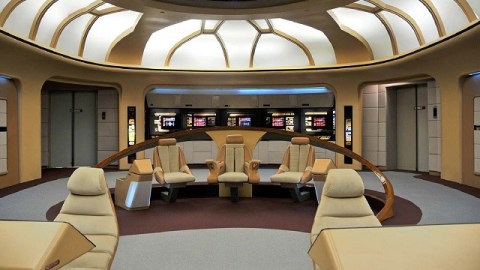Why Does the NSA Control Center Look Like the Bridge From Star Trek?

Growing up, I fell in love with Science Fiction watching reruns of Star Trek, the version now known to fans as “The Original Series.” The storylines and (then state of the art) special effects hooked me early on, but it was the interplay between William Shatner’s Captain James T. Kirk, Leonard Nimoy‘s Spock, and DeForest Kelley‘s Doctor Leonard “Bones” McCoy that kept me watching decades later. So many movies and so many spin-off series later, Gene Roddenberry’s brainchild continues to meld with the minds of those who watched it as youngsters. I thought of all that when I read journalist Glenn Greenwald (he of the Edward Snowden NSA revelations) reveal that National Security Agency chief General Keith B. Alexanderhired a Hollywood set designer to make his NSA command center, dubbed the “Information Dominance Center,” look like the bridge of the Starship Enterprise, complete with oversized view screen, computer stations, captain’s chair, and sliding doors with the signature Star Trek “whoosh” sound. Aside from the impracticality of the idea (and potential tax dollars wasted), what does it mean that the NSA control center looks like Jean-Luc Picard’s workplace (shown above)?
If you don’t believe me, look for yourself at what are purported to be pictures of the actual “Information Dominance Center” (scroll down). General Alexander not only indulged in his Trek fantasy himself, but invited congressional visitors to sit in the captain’s chair and watch a presentation on the big screen. “Everybody wanted to sit in the chair at least once to pretend he was Jean-Luc Picard,” Greenwald’s source quotes a retired officer in charge of VIP visits. How far this “boys with toys” scenario played out is unclear, but I can’t believe that nobody let an “Engage!” or “Make it so!” pass their lips. Rumors of Redshirts providing security remain unconfirmed (mostly because I just made them up).
A lot has been written about how Star Trek influenced the course of technology. A lot of what we use in our everyday lives today works and looks the way it does because some Sci-Fi writer or prop master dreamed it up for the show. So, it’s understandable that General Alexander would tap into the futuristic cache of Star Trek to underscore the futuristic technology behind the NSA’s surveillance programs. But what confounds me in this borrowing is how General Alexander seems to miss the entire point of the series. Looking back at Roddenberry’s vision now, it’s impossible to miss the ultimate liberal, hippie utopia—not just races and genders, but whole alien species working together to promote peace and understanding throughout the universe. Nichelle Nichols wore that short skirt and go-go boots as Lieutenant Nyota Uhura, communications officer, not as symbols of sexism, but as symbols of strong women with the freedom (which “Uhuru” means in Swahili; “Nyota” means star, by the way) to make their own choices. Roddenberry looked around the racial and sexual landscape of America in the late 1960s and created the world he hoped would someday rise from those ruins.
Perhaps Alexander watched the landmark episode “Mirror, Mirror” and came away with the wrong lesson. In that 1967 episode, the crew beam down to a planet containing rare, valuable natural resources. The locals refuse to accept Kirk’s offer. Just as he’s about to beam back to the ship, Kirk turns to the locals and tells him that he has the power to force them to give in, but would never use it—something they should consider when choosing whom to deal with. As Kirk and the landing party return to the ship, a malfunction swaps “good” Kirk and crew with “bad” Kirk and crew across parallel universes. Good Kirk finds himself face to face with amoral, evil Spock, who you know is evil because he has a goatee. The evil universe is full of cutthroats hungry for power and a pervasive paranoia where nobody feels safe. Good Kirk learns that Bad Kirk (also trapped, but in the good universe) owes his status as captain to a device called the Tantalus Field that allows him not just to spy on his enemies, but also to make them disappear with the push of a button.
Try thinking of the Tantalus Field’s ability and not think of the recent Snowden revelations or of push-button assassinations via drone warfare. And, yet, here’s the NSA adopting the Star Trek flashy exterior but none of its moral core. I don’t consider myself a “Trekker” (or the more nerd-laden term “Trekkie”), but even I see the disconnect and, even worse, the misconnect. Are we all just trapped in the “bad” universe, where someone can call a center to spy on innocent people with total disregard for their rights the “Information Dominance Center”? I wonder how many congresspersons sat in that captain’s chair and ordered phasers or photon torpedoes in jest, forgetting that the show was all about exploring, negotiating, and uniting diversity while respecting uniqueness, not about bombing. If none of them did, you might as well have Bones lean over the Constitution and say, “It’s dead, Jim.”





